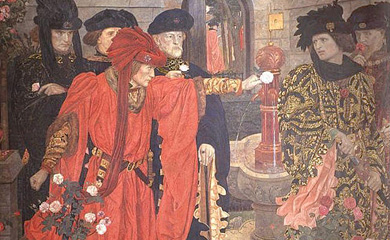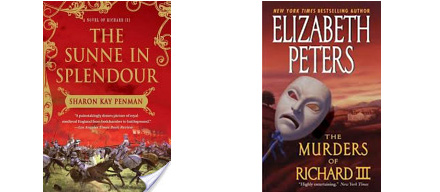
Last month news story headlines all over the world confirmed that bones exhumed from under a parking lot in Leicester, England, are those of Richard III, King of England from 1483–1485. Last of the Plantagenet dynasty that had ruled England since 1154, Richard was killed—the last English king to die in battle—fighting the forces of Henry Tudor, who became Henry VII and the founder of the Tudor ruling line.
So what? This was over 500 years ago. Besides, Richard III was a bad king and a worse human being. Now if it was King Arthur’s bones that had been discovered… But actually, Richard III—or more accurately, the image most people have of Richard—is surprisingly relevant to our time. We think of political spin as something from modern times, but in reality, it’s been going on for centuries.
Thanks primarily to William Shakespeare, Richard is best known as one of history’s great villains, responsible for (at least) usurping the throne, murdering his two nephews, having lustful designs on his own niece, and committing other random murders along the way. He also was hunchbacked, limped, and had a withered arm and squinty eyes.

William Shakespeare’s version of the splitting of nobles into the factions of York and Lancaster, sparking the Wars of the Roses in 15th-century England.
Artist: Henry Arthur Payne (1868–1940).
Image credit: Wikimedia Commons, public domain
The problem with the popular notion of Richard is that much, if not most to all of it, is untrue. In the time period Shakespeare was writing, Henry Tudor’s granddaughter, Elizabeth I, was on the English throne. Shakespeare would have certainly been aware that pleasing the monarch was the best way to success (including keeping one’s head attached to one’s shoulders), so he would have been extremely unlikely to write anything positive about the man Elizabeth’s grandfather had killed. The sources that Shakespeare drew upon in writing Richard III were similarly biased. John Rous, a chronicler writing during Richard’s reign, lauded Richard as a good king with a good heart, who stood up for the common man. But after Richard’s death and the ascension of Henry VII, Rous described Richard as physically deformed and born with teeth and shoulder-length hair after spending two years in the womb. Other chroniclers took that description and ran with it…but in the process Richard’s supposedly withered arm moved from his right to his left. Oops. And portraits of Richard have, upon examination, revealed evidence of repainting to add uneven shoulders and squinty eyes. Double oops.
Similarly, most supposed murders by Richard took place during the reign of Richard’s older brother, Edward IV, and there is no evidence linking Richard with either planning or executing them. The two that did occur during Richard’s reign were both cases of treason, which was punishable by death. The only uncertain case is central to the idea of Richard as villain, though—the murders of his young nephews, commonly known as the Princes in the Tower, and one of the most famous unsolved historical mysteries.

“The Princes in the Tower”
Artist: John Everett Millais (1829-1896)
Image credit: Wikimedia Commons, public domain
The popular image of the princes is two young boys, one an anointed king, imprisoned in the infamous Tower of London and later secretly killed, either by Richard himself or on his orders, to preserve his usurpation of the English throne. The reality is much more complicated and involves a secret marriage, a possible secret betrothal, possible illegitimacy, power-hungry courtiers, and bitter divisions between the two major “parties” of the time. Briefly, Edward IV, from the Yorkist branch of the royal family, secretly married a woman named Elizabeth Woodville, whose family members were placed in positions of power in any way possible, causing major resentment of the entire Woodville family. After Edward IV’s death in April 1483, the former chancellor for Edward, a bishop of the Church, came forward and claimed that Edward had been betrothed to another woman before marrying Elizabeth. In those days a betrothal, or plight-troth, was as binding as a marriage; thus, Edward’s marriage to Elizabeth was invalid and all of their children, including the two princes, were illegitimate. Consequently, as Edward’s younger brother, Richard was the closest legitimate heir to the throne.
Before the bishop’s revelation, Edward’s older son, also named Edward, had gone to the Tower of London, which at that time was not only a prison, but contained living quarters. (Traditionally, heirs to the throne lived there before their coronations.) Elizabeth Woodville soon allowed Edward’s younger brother to join him. The boys were seen playing outside during the summer of 1483, but by late fall rumors were circulating that the boys were dead. The only certainty is that they were not seen alive after the summer of 1483.
There are others suspected of murdering the princes. Henry Stafford, the Duke of Buckingham, had initially supported Richard against the Woodville family, but less than six months later led a rebellion against Richard. Henry Stafford was related to the Yorkist royal family and potentially had his eye on the throne, and removing any potential claimants to the throne, even illegitimate sons, would have been in his interest. Henry Tudor was distantly related to the rival branch of the royal family, the Lancastrians, but his claim was tainted for two reasons: it was through a female line of descent, and it was through illegitimacy. Because of these reasons, Henry Tudor’s claim to the throne was very tenuous, and he would have had even stronger reasons for wanting rival claimants to the crown removed.
Richard nearly defeated Henry Tuor at the Battle of Bosworth Field in August 1485. Henry was saved only by the treachery of one of Richard’s supporters, who turned his army against Richard’s during the battle, and by multiple fighters of Henry’s own household, who brought Richard down after Richard’s single-minded charge across the battlefield almost reached Henry himself, coming so close as to kill Henry’s standard-bearer. Henry’s troops hacked and defiled Richard’s body, which was then buried with no ceremony in the grounds of Greyfriars’ Church in nearby Leicester. During the Dissolution under Henry’s son, Henry VIII, the church was destroyed. For a long time it was thought that Richard’s body had been disinterred and thrown into the River Soar.
In the end, history was written by the winner. Henry Tudor became Henry VII, married Elizabeth of York, the eldest daughter of Edward IV, and subsumed all claims to the English throne into his own family. Under the rule of Henry VII and Henry VIII, most of the male members of the House of York were executed, removing any possibility that a York might claim the throne. Chroniclers of the era painted Richard with the blackest of brushes to further delegitimize the House of York and appeal to the Tudor family. These are the sources upon which Shakespeare drew to write Richard III, and these are what have shaped Richard’s reputation over the last five centuries. Five centuries from now, what sources will historians of that time be using to write the history of today—and how truthful will they be?
If you’re interested in reading more about Richard III, Milne Library has some great resources! Check GLOCAT Classic for copies of Shakespeare’s Richard III, both in print and in video form, as well as a wide range of sources about the history of late 15th-century England and Richard’s reign, by searching for “Richard III” OR “Richard the Third.” (Be sure to use the quotation marks to ensure that the search engine looks for “Richard” and “III” or “the Third” together as a phrase!) And while two excellent historical novels about Richard III aren’t part of the library’s holdings, you can use interlibrary loan through IDS (available from the library’s homepage under the tab labeled “Requests and Services”) to find copies of Sharon Kay Penman’s thoroughly researched The Sunne in Splendour and Elizabeth Peters’ lighthearted yet historically accurate mystery novel The Murders of Richard III.  For information on the discovery and retrieval of Richard’s bones, and the ongoing argument as to where the skeleton will be interred, Lexis-Nexis (on the library’s homepage under “Popular Resources”) is the place to go for newspaper, magazine, and other current media stories from around the world. Searching on “Richard III” retrieves almost 1,000 stories; “Richard the Third” as a search term is less focused, mixing in stories about rugby players and such, but still retrieving some interesting stories. And for a look at the scholarly literature, Historical Abstracts, which can be found by using the “Find a resource by title” search box below “Popular Resources” on the library’s homepage, produces over 100 results, including articles on Richard himself, Shakespeare’s play, and the sources he drew on, especially Thomas More’s account of Richard’s life.
For information on the discovery and retrieval of Richard’s bones, and the ongoing argument as to where the skeleton will be interred, Lexis-Nexis (on the library’s homepage under “Popular Resources”) is the place to go for newspaper, magazine, and other current media stories from around the world. Searching on “Richard III” retrieves almost 1,000 stories; “Richard the Third” as a search term is less focused, mixing in stories about rugby players and such, but still retrieving some interesting stories. And for a look at the scholarly literature, Historical Abstracts, which can be found by using the “Find a resource by title” search box below “Popular Resources” on the library’s homepage, produces over 100 results, including articles on Richard himself, Shakespeare’s play, and the sources he drew on, especially Thomas More’s account of Richard’s life.


